News&Press
12/17/20
5 mins de lecture
The concept of digitalization, perhaps even Digital Transformation, is now completely obvious in our minds, nonetheless, do we truly realize what is at stake? Some people associate digitalization with digital technology therefore to Digitization or Informatization. Nevertheless, those 3 notions are quite different, both in their primary origins and in the transformations they imply within businesses and their markets.
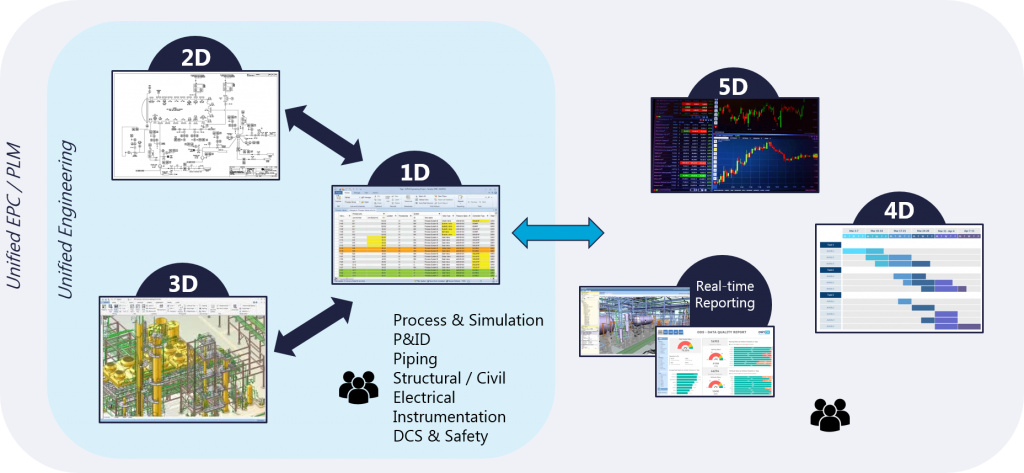
To understand digitalization and its stakes, it is important to precisely define it to genuinely seize its meaning and distinguish it from the other notions. Only then, the basis of a digital transformation procedure can be laid by introducing the notion of digital maturity.
Digitization | Informatization | Digital Transformation
Digitization can be defined as the use of possibilities offered by new technologies while keeping the same purposes. It offers the same services but new digital tools are added to pre-existing systems. We then speak of the digitization of the activity.
In engineering, it implies that all physical documents are scanned (plans, data-sheets, acceptance reports, dispatch notes…) and archived on servers. Data is purely « stored » and take up less memory. However, these are uneditable, abstract versions that are hardly exploitable within a digitalization or even digital transformation strategy.
When a project ends, the final client receives numeric data, much less voluminous than tons of technical paper documents kept in a trailer on a parking lot. Though, there remain a few issues: information access and retrieval. This digitized data is not recoverable without the structuring of information, which can prove itself more important than a digitalization procedure.
Informatization is the second step toward digital transformation. It consists in « getting at an industrial level », meaning doing what is expected and probably already existing in competing industries. Its first level is called « computerization », quite an unambiguous name according to the German frame of reference « Industrie 4.0 Maturity Index » by Acatech(1).
At this level of maturity, technologies are used separately and without being integrated into one another. Every department of the industry keeps working in silos. For example, in an industrial design department, modeling will be carried out with a CAO tool (E3D, CATIA, SOLIDWORKS,…), then exported to AUTOCAD for the creation of plans. The latest will need to be printed, annotated – or signed – by hand, then scanned to eventually become available to anyone in charge of projects, via an Electronic Document Management System (EDMS).
It is important to notice that informatization often improves data reliability compared to paper-based work methods. It also allows to avoid duplications in data entries and it eases data sharing. Informatization being already widely set up in most companies, it is mainly used to improve the efficacy of daily and repetitive tasks, however its use is nothing revolutionary.
Digital transformation consists in reinventing processes and imagining new systems, products, and services by using new technologies possibilities and opportunities. It represents the mastery of modern digital technologies and their commissioning in the company’s business. In that way, digital transformation creates the mutation of business models, that therefore need to be redesigned based on new possibilities offered by technology. The aim of digital transformation is to break traditional silos in order to allow the different teams to work in a unified data-centric environment.
Now, engineering enjoys efficient solutions allowing to work in 1D, 2D, 3D… or even 6D environments. Those environments are completely integrated and communicate with each other. Design changes on the equipment can then be quickly identified and associated plans can be automatically recovered according to a materials list that can be updated if need be. It is even possible to assess in real time the cost and schedule impact of this modification before validating it for its inclusion in 3D design.
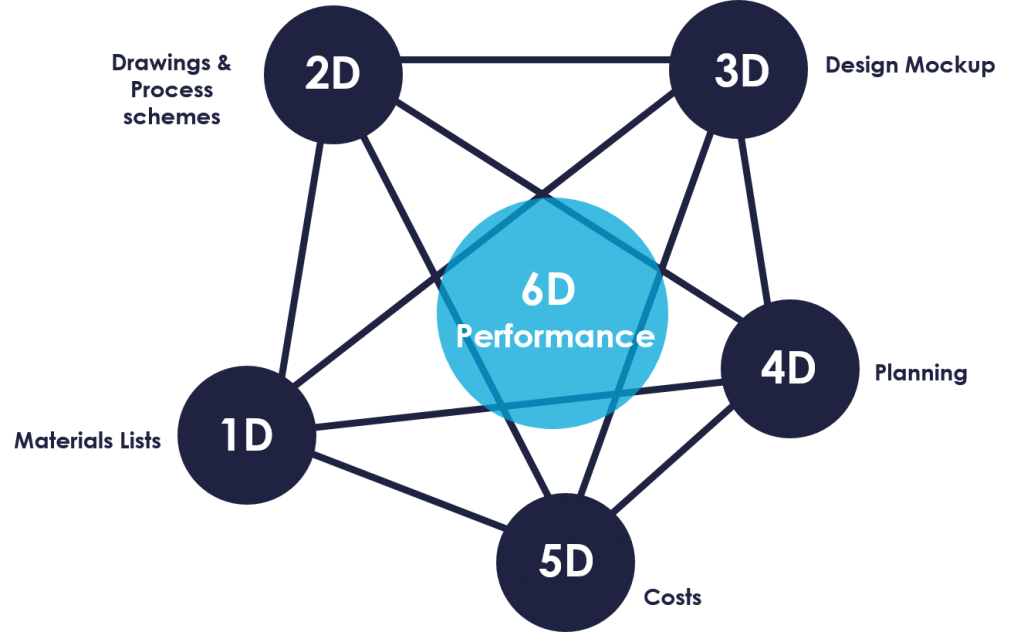
Well-aware of potential stakes and profits available in new markets or by optimizing their activity performances, organizations now face new opportunities. For these companies, the aim is clear: transform to progress faster, more efficiently and qualitatively in their core businesses. This particularly applies to EPC (Engineering Procurement Construction) type industrialists, that have now access to solutions allowing them to manage all of their organization-and-internal-process-related activities. Those EPC4.0 solutions bring a genuine added value to project management and represent a wonderful opportunity to jump aboard the train of digital transformation.
It is important to notice that the inadvertent or maintained confusion of these 3 expressions remains common: way too few companies investing in digital tools implementation, such as tablets, share their digital transition, transformation and even revolution. However, by making these already banalized technologies available to the greatest number (clients and/or staff), all they do is digitize their activity(ies). According to most digital maturity frames of reference, these companies would not go beyond level 0, meaning the basics.
A few models of digital maturity
Each different model of digital maturity follows one or multiple lines to assess the maturity level of an organization regarding its digital transformation.Infosys assesses businesses’ maturity depending on their willingness to integrate technology innovations. Thus, in its Digital Radar 2020(2) report, Infosys ranks businesses’ maturity into three large groups:
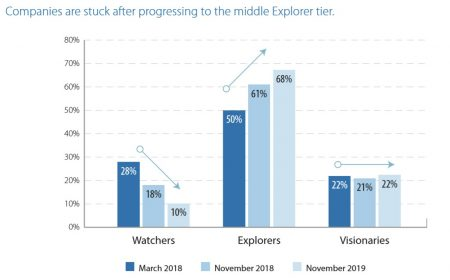
According to a collaborative study by MIT and Capgemini(3), maturity is assessed following 2 lines: the first one is the digital intensity; the second one is the digital transformation management of the company, within the company. If the digital intensity is about investment in digital-technology-based initiatives to change the company’s way of proceeding, the second line is about change management and process. This change impacts the company’s commitments to the clients as well as the way internal operations and business model are carried out. 4 types of businesses stand out:
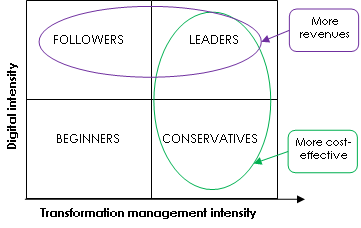
Newly-established companies (« Beginners ») are recognizable by their limited experimentations. Even though they show a certain maturity regarding ERP traditional apps, or electronic trade for example, the lack of a strategic vision, and the skepticism regarding 4.0 opportunities pushes them into a state of immaturity concerning digital transformation.
« Fashionistas » companies (let us call them « Followers ») gladly experiment new digital opportunities but not in a coordinated way, meaning without being connected to the global functioning of the company and its market possibilities.
« Conservatives » prefer caution over innovation. They share with the Beginners a certain skepticism concerning 4.0 opportunities. Finally, companies called digerati (let us call them « Leaders ») are those having the best maturity rates for they massively invest in different technology opportunities in a coherent and coordinated way, with clear objectives regarding their business model.
The study highlights the fact that companies with a strong digital intensity will have better performances on their capital assets, while those with a true mastery of transformation management will be more cost-effective.
Finally, a full study, conducted by Acadech (National German Academy of science and engineering), on businesses’ maturity level highlights an interesting approach of digitalization as the basics of Industry 4.0 and a value creation driver for the companies of this sector. Without any classification, this study invites companies to progressively start their transformation by successively taking part in the following 6 steps: computerization, connectivity, exposure, transparency, projection capability and finally adaptability.
At Orinox, we consider that this maturity model must be completed by level 0 (digitization phase). This first and essential step, as explained before, gives the basic premises of a transformation procedure toward the Industry 4.0.
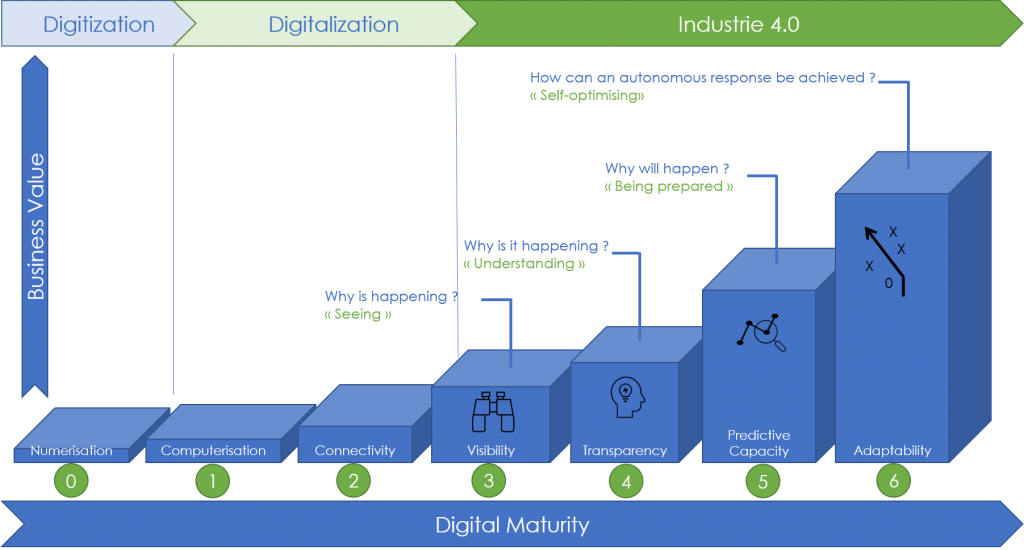
Among all those strategies, one permanent feature stands out: digital transformation is considered as one of the performance and profitability drivers for businesses, especially those from the energy, process and naval sectors. Today, those businesses are still lagging behind on these matters. Digital transformation makes possible the achievement of their goals through a systemic approach (opposed to management in silos) in every phase of their projects and in every internal department of the company.
Now, unified technological solutions exist and allow the achievement of digital transformation. The challenge dwells in the change management and process: both need to accompany strategic decisions that aim at expanding the procedure.
Authors
Ulrich KOMENAN – Lead, Operations Pilot (Author)
Maxime FOURREAU – Technology evangelist for Plant Digital Asset (Contributor)
Alexia BOUDET – Project Coordinator and R&D (Contributor)
References